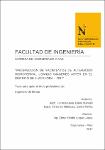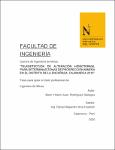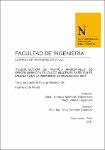Mostrar el registro sencillo del ítem
Teledetección de áreas de interés prospectivo metálico usando imágenes aster y landsat oli-tirs en el distrito de Namora, Cajamarca
| dc.contributor.advisor | Alva Huamán, Daniel Alejandro | |
| dc.contributor.author | Julcamoro Alcantara, Patricia Yovanna | |
| dc.contributor.author | Julcamoro Alcantara, Victor | |
| dc.date.accessioned | 2018-08-29T23:32:10Z | |
| dc.date.available | 2018-08-29T23:32:10Z | |
| dc.date.issued | 2018-07-20 | |
| dc.identifier.citation | Julcamoro, P. Y., & Julcamoro, V. (2018). Teledetección de áreas de interés prospectivo metálico usando imágenes aster y landsat oli-tirs en el distrito de Namora, Cajamarca (Tesis de licenciatura). Repositorio de la Universidad Privada del Norte. Recuperado de http://hdl.handle.net/11537/13780 | es_PE |
| dc.identifier.other | TES 622 JULC/T 2018 | es_PE |
| dc.identifier.uri | https://hdl.handle.net/11537/13780 | |
| dc.description.abstract | RESUMEN El Perú es un país de antigua y rica tradición minera, por ende, es de gran importancia la implementación de nuevas técnicas de prospección de manera que permita obtener resultados de manera objetiva y simplificada, tal es el caso de la teledetección que es una técnica económicamente rentable y que abarca grandes extensiones de espacio-tiempo, técnica que será implementada en la presente investigación la cual tiene como objetivo principal de Identificar áreas de interés prospectivo de yacimientos económicamente rentables, utilizando teledetección, mediante imágenes satelitales Áster y Landsat OLI – TIRS. Para realizar la presente investigación se debe adquirir las imágenes satelitales ASTER y Landsat de la zona de estudio con características atmosféricas favorables, se realiza la corrección atmosférica y radiométrica con la finalidad de procesar toda la información de reflactancia que tenga la imagen, posteriormente se realiza un remuestreo para homogenizar la resolución espacial a 15 metros pixel, consecuentemente se realiza el enmascaramiento para filtrar toda información que sea innecesaria en el estudio y finalmente ser realiza el análisis espectral de los pixeles puros de información que tenga tanto la imagen ASTER como la imagen Landsat. Obteniéndose así zonas con interés prospectivo con presencia de minerales como: Calcita, Caosmectita, Corindón, Cuarzo, Diásporo, Epidota, Illita, Muscovita, Tremolita-Actinolita, turmalina, evidenciando la ocurrencia de alteraciones minerales tales como propilítica, potásica y argílica según la clasificación mineral de Leach, 1998. Concluyendo así que es posible identificar áreas de interés prospectivo de yacimientos económicamente rentables, utilizando teledetección, mediante imágenes satelitales Áster y Landsat OLI – TIRS. | es_PE |
| dc.description.abstract | ABSTRACT Peru is a country of ancient and rich mining tradition, therefore, it is of great importance the implementation of new prospecting techniques in order to obtain results in an objective and simplified manner, such as remote sensing, which is a technique economically profitable and covering large extensions of space-time, a technique that will be implemented in this research which has as main objective to identify areas of prospective interest from economically profitable sites, using remote sensing, using satellite images Aster and Landsat OLI - TIRS. In order to carry out the present investigation, the ASTER and Landsat satellite images of the study area with favorable atmospheric characteristics must be acquired, the atmospheric and radiometric correction is carried out in order to process all the reflectance information that the image has, then a resampling to homogenize spatial resolution at 15 meters pixel, consequently masking is done to filter all information that is unnecessary in the study and finally to perform the spectral analysis of the pure pixels of information that has both the ASTER image and the Landsat image. Obtaining thus areas with prospective interest with the presence of minerals such as: Calcite, Chaosmectite, Corundum, Quartz, Diasporum, Epidote, Illita, Muscovite, Tremolite-Actinolite, Tourmaline, evidencing the occurrence of mineral alterations such as propylitic, potassium and argillic according to the classification Leach mineral, 1998. Concluding that it is possible to identify areas of prospective interest from economically profitable fields, using remote sensing, using Aster and Landsat OLI - TIRS satellite images. | es_PE |
| dc.description.uri | Tesis | es_PE |
| dc.format | application/pdf | es_PE |
| dc.language.iso | spa | es_PE |
| dc.publisher | Universidad Privada del Norte | es_PE |
| dc.rights | info:eu-repo/semantics/openAccess | es_PE |
| dc.source | Universidad Privada del Norte | es_PE |
| dc.source | Repositorio Institucional - UPN | es_PE |
| dc.subject | Metales | es_PE |
| dc.subject | Electromagnetismo | es_PE |
| dc.subject | Minerales | es_PE |
| dc.title | Teledetección de áreas de interés prospectivo metálico usando imágenes aster y landsat oli-tirs en el distrito de Namora, Cajamarca | es_PE |
| dc.type | info:eu-repo/semantics/bachelorThesis | es_PE |
| thesis.degree.grantor | Universidad Privada del Norte. Facultad de Ingeniería | es_PE |
| thesis.degree.level | Título Profesional | es_PE |
| thesis.degree.discipline | Ingeniería de Minas | es_PE |
| thesis.degree.name | Ingeniero de Minas | es_PE |
| dc.publisher.country | PE | es_PE |
| dc.subject.ocde | https://purl.org/pe-repo/ocde/ford#2.07.05 | es_PE |
| thesis.degree.program | Pregrado | es_PE |
| dc.description.sede | Cajamarca | es_PE |
| renati.discipline | 724026 | es_PE |
| renati.level | https://purl.org/pe-repo/renati/level#tituloProfesional | es_PE |
| renati.type | https://purl.org/pe-repo/renati/type#tesis | es_PE |
Ficheros en el ítem
Este ítem aparece en la(s) siguiente(s) colección(ones)
-
Tesis [528]





